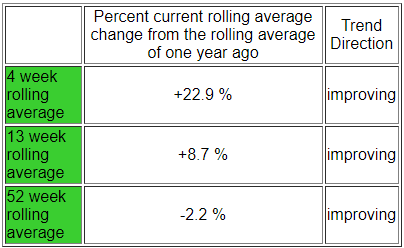Rail Week Ending Saturday April 17 - Carload Growth Now In Positive Territory Year-To-Date Compared To 2020
Week 15 of 2021 shows the same week total rail traffic (from the same week one year ago) improved according to the Association of American Railroads (AAR) traffic data. Total rail traffic - which has been in contraction for over one year - is now surging as it is being compared to the pandemic lockdown period one year ago.

Analyst Opinion of the Rail Data
We are now seeing great rail growth as the data is being compared to the coronavirus lockdown period last year.
Total rail traffic has two components - carloads and intermodal (containers or trailers on rail cars). This week again intermodal continued in expansion year-over-year and continues on a strengthening trendline.
Carloads 4-week rolling average is in expansion when compared to the 4-week rolling average one year ago.
Rail is now growing year-over-year.
We review this data set to understand the economy. The intuitive sectors (total carloads removing coal, grain, and petroleum) expanded 35.3 % year-over-year for this week. We primarily use rolling averages to analyze the intuitive data due to weekly volatility - and the 4 week rolling year-over-year average for the intuitive sectors improved from +9.8 % to +19.5 %
When rail contracts, it suggests a slowing of the economy.
The following graph compares the four-week moving averages for carload economically intuitive sectors (red line) vs. total movements (blue line):
(Click on image to enlarge)
.
This analysis is looking for clues in the rail data to show the direction of economic activity - and is not necessarily looking for clues of the profitability of the railroads. The weekly data is fairly noisy, and the best way to view it is to look at the rolling averages (carloads [including coal and grain] ).
(Click on image to enlarge)

A summary for this week from the AAR:
For this week, total U.S. weekly rail traffic was 533,217 carloads and intermodal units, up 32.2 percent compared with the same week last year.
Total carloads for the week ending April 17 were 237,607 carloads, up 25.2 percent compared with the same week in 2020, while U.S. weekly intermodal volume was 295,610 containers and trailers, up 38.3 percent compared to 2020.
For some rail traffic categories, percentage changes for the current week compared with the same week in 2020 are inflated because of the widespread shutdowns — and subsequent large reduction in rail volumes — that impacted many economic sectors last year at this time.
Nine of the 10 carload commodity groups posted an increase compared with the same week in 2020. They included coal, up 13,166 carloads, to 61,600; motor vehicles and parts, up 10,606 carloads, to 12,549; and metallic ores and metals, up 7,533 carloads, to 24,803. One commodity group posted a decrease compared with the same week in 2020: petroleum and petroleum products, down 120 carloads, to 10,829.
For the first 15 weeks of 2021, U.S. railroads reported cumulative volume of 3,382,004 carloads, up 0.2 percent from the same point last year; and 4,195,580 intermodal units, up 15.7 percent from last year. Total combined U.S. traffic for the first 15 weeks of 2021 was 7,577,584 carloads and intermodal units, an increase of 8.2 percent compared to last year.
The middle row in the table below removes coal, grain, and petroleum from the changes in the railcar counts as these commodities are not economically intuitive.
(Click on image to enlarge)

(Click on image to enlarge)

Disclaimer: No content is to be construed as investment advise and all content is provided for informational purposes only.The reader is solely responsible for determining whether any investment, ...
more



